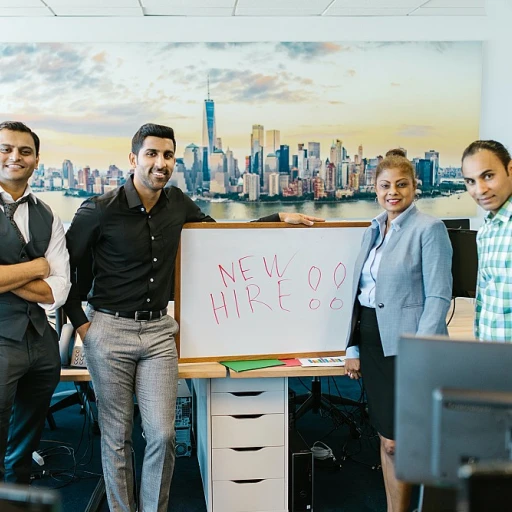Understanding the Storming Stage
Navigating the Complex Waters of Early Team Development
In the journey of team development, the storming stage is a critical phase that can't be overlooked. This stage often emerges after the initial excitement of forming has worn off and involves team members experiencing conflicts and challenges as they work to establish their roles and dynamics within the group.
While the forming stage is characterized by politeness and enthusiasm, the storming stage is marked by a palpable shift as reality sets in. Team members may start to express frustrations or differences in opinions and approaches. These conflicts can feel overwhelming, but they are a natural part of the development process. Recognizing this stage helps in mitigating potential conflicts and steering the team towards the more stable norming and eventually performing stages.
Understanding the storming phase involves acknowledging the role of conflict in fostering growth and development within the group. Conflict, although challenging, is not inherently negative. It can stimulate dialogue, innovation, and problem-solving, ultimately leading to a high performing team if managed correctly.
As teams work through this stage, emotions may run high, and productivity might temporarily dip. It's crucial for team leaders to anticipate these dynamics and have strategies in place that focus on effective communication, conflict resolution, and collaborative team building. With strategic management, teams can navigate this difficult landscape and emerge stronger and more cohesive.
As part of understanding these dynamics further, a comprehensive look at Tuckman's stages of group development can provide deeper insights. Exploring Tuckman's model gives understanding into enhanced employee engagement as it sheds light on the predictable stages through which teams evolve and grow.
Identifying Common Challenges
Typical Hurdles in the Storming Phase
The storming stage of team development is characterized by a mix of challenges that can impact both team performance and individual dynamics. Understanding these obstacles is essential for effective management and steering the group towards high performing outcomes.
Conflicts and Disagreements
One of the primary challenges in the storming stage is conflict. As team members become more familiar with each other’s working styles and personalities, disagreements may arise. This is a natural part of the team building process. Some level of conflict can be healthy, as it encourages members to address differences and work through them. However, unmanaged conflicts can hinder the team’s ability to move forward.
Resistance to Authority
During this stage, some group members may resist the leadership of the team leader, questioning their decisions or directives. This resistance can be a result of unclear objectives or a lack of trust in leadership. It is crucial for the leadership to establish credibility and foster an environment of trust and respect to navigate these challenges. For more insights, check the stages of group development.
Struggles with Role Definition
Another common challenge is the ambiguity in roles and responsibilities. Team members may not fully understand their position within the group, leading to overlaps or neglect of certain tasks. This can slow down the project management process and impact overall performance. Clarity in roles and expectations is vital to help team functionality.
Lack of Cohesion
The norming stage is marked by a development of cohesion and collaboration, but during the storming phase, a lack of cohesion can be prevalent. Team members may not yet have developed a strong sense of collaboration or aligned towards common objectives. This can result in a fragmented team dynamic, impeding the group’s ability to achieve their goals effectively.
Addressing these common challenges requires a blend of strong leadership and strategic communication. Fostering an environment where open dialogue is encouraged will help navigate these hurdles and set the stage for the performing phase.
Strategies for Effective Communication
Implementing Communication Frameworks for Clarity
Effective communication is crucial when dealing with the storming stage of team development. This stage is often marked by misunderstanding and conflict among group members, which can impede team performance if not addressed promptly. A structured communication process will help teams navigate these challenges, ensuring that all members are heard and understood. One of the first steps in fostering effective communication is to establish clear channels. Open communication channels enable team members to express their concerns and insights during group discussions without fear of retribution or misunderstanding. Utilizing tools like regular team meetings, anonymous feedback platforms, or even daily check-ins can help maintain open lines of communication.Encouraging Active Listening and Constructive Feedback
Active listening is a skill that can significantly improve the quality of dialogue within a team. It involves focusing entirely on the speaker, understanding their message, and responding thoughtfully. This level of engagement not only helps resolve conflict but also strengthens group cohesion by showing respect and valuing different perspectives. Promoting constructive feedback is equally important. Team members should be encouraged to express their thoughts and critiques in a manner that is helpful and forward-thinking. This can be especially beneficial in the project management process, where different views can lead to innovative solutions and improvements in team performance. For more strategies on enhancing communication within your team, consider exploring the Six Thinking Hats Method, which provides diverse perspectives that can aid in group problem-solving.Facilitating Transparent and Open Dialogue
Transparency is another critical component of effective communication. Leaders should ensure that all team members have access to the information they need to perform their roles efficiently. This involves not just sharing updates and progress, but also being honest about challenges and setbacks that the team might be facing. A transparent communication culture fosters trust and can significantly mitigate misunderstandings and reduce conflict during the storming stage. This approach not only promotes an atmosphere of openness but also prepares the team for the norming stage, where collaboration and cooperation begin to flourish.Fostering Collaboration and Team Cohesion
Creating a Cohesive Work Environment
Developing a strong sense of collaboration among team members is crucial during the storming stage of team development. This stage often involves conflicts and disagreements as group members start asserting their individual perspectives. To navigate through this stage effectively, fostering a cohesive and collaborative environment becomes vital. One key approach involves creating a culture that prioritizes teamwork over individual performance. This can be achieved by emphasizing the collective goals of the team rather than focusing on personal achievements. Encouraging open communication will allow team members to express their ideas and opinions, there-by preventing misunderstandings and reducing potential conflicts. Additionally, establishing clear roles and responsibilities within the team can significantly aid in enhancing cohesion. When each member understands their role and the responsibilities of others, it contributes to a smoother workflow and minimizes overlaps that can cause friction. Regular team meetings can offer an opportunity for members to discuss challenges, share insights, and collectively find solutions, reinforcing a sense of belonging. Activity-based team building exercises are another effective way to strengthen collaboration. Engaging in structured activities helps promote communication and trust among team members. This not only contributes to better team performance in the long run but also aids in accelerating the progression from the storming stage to the performing stage. Implementing intentional team-building initiatives can significantly boost morale and foster a connected team culture. Ensuring that each team member feels heard and valued can also propel the group towards achieving its potential. When leadership involves team members in decision-making processes and acknowledges their contributions, it fosters mutual respect and collaboration, paving the way for a high-performing team. By consistently working to improve collaboration and team cohesion, organizations can successfully navigate the challenges of the storming stage while setting a strong foundation for future stages of development, such as norming and performing.Leadership's Role in the Storming Stage
Guiding Through the Turbulence
During the storming stage of team development, leadership plays a critical role in navigating through the challenges that arise. This phase is often marked by conflict and tension as team members are working through their differences. Effective leadership is essential to help team members manage these conflicts and focus on the goal of becoming a high performing team. Providing Direction and Clarity Leaders must provide a clear vision and set expectations to guide the team effectively. This clarity is vital as teams transition from the forming stage and engage in more critical group development. By ensuring that each team member understands their role and the stages the group will go through, leaders can mitigate confusion and prevent conflict from stalling team performance. Encouraging Open Dialogue A key strategy for leaders is to foster an environment where open communication is encouraged. During the storming stage, team members should feel empowered to voice their concerns and ideas without fear of retribution. Effective management involves creating channels for feedback that contribute to the team’s development process, aiding in transitioning towards the norming stage. Mediating Conflicts Constructively Conflicts are inevitable in this stage, but the way they are addressed is crucial. A successful leader not only helps team members articulate their differences but also aids them in finding common ground. As a mediator, a team leader ensures that conflict is seen as a tool for growth rather than a setback. Leading by Example Leadership in the storming stage demands more than direction and management; it requires setting an example of how to handle the storming challenges. By demonstrating resilience and adaptability, leaders can inspire team members to adopt these behaviors, paving the way for a cohesive and productive environment. Providing Support and Resources Finally, leaders must ensure that the team has the necessary resources to succeed. This can involve both tangible resources like training and information, and intangible support such as encouragement and recognition. Leaders should prioritize activities that foster team building and promote team cohesion. In the journey from storming to performing, the leader's role is crucial in shaping not only the team's performance but also their development as a cohesive group. By focusing on these strategies, leaders can effectively guide their team through the storming challenges and toward achieving their project goals.Measuring Success and Moving Forward
Assessing Progress and Setting Future Goals
As teams progress through the storming stage, it’s essential to measure their success and plan for the journey ahead. This phase involves evaluating both team and individual performance, acknowledging achievements, and identifying areas for improvement. By doing so, you can ensure that your team transitions smoothly into the subsequent stages of development.
One way to measure success is by assessing the resolution of conflicts and how well team members are collaborating. Successful management of the storming stage can be observed through reduced misunderstandings and increased cooperation, indicating that the team is on track to reach the performing stage. Monitoring these dynamics helps in understanding group development and how effectively the team is working together.
Utilizing Feedback for Growth
Gathering feedback from team members is a vital aspect of this process. It provides insights into the team’s morale and helps identify any lingering issues that might affect future performance. Encourage team members to share their perspectives on the challenges they faced during this stage. This collective reflection can offer valuable lessons for team building and improving team dynamics in future projects.
The feedback gained should be used to set clear, attainable goals for the future. These goals might focus on enhancing communication, fostering collaboration, or improving project management practices. Setting a course for improvement not only motivates the team but also assures them that their development is a continuous process supported by leadership.
Monitoring and Celebrating Achievements
As the team progresses, regularly monitor performance metrics to ensure that the group is moving in the right direction. This ongoing assessment helps in maintaining a high performing team by providing timely interventions if needed.
Lastly, don't forget to celebrate achievements—big and small. Recognizing progress boosts morale and reinforces a positive cycle of engagement and productivity. Celebrating achievements signals to team members that their hard work is valued and encourages continued effort as they move towards the norming and performing stages of development.












